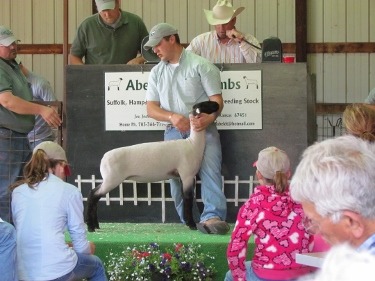“You have to like what you’re raising, or it’s no fun doing all of the work. Our goal is to produce a consistent lamb crop that is structurally correct, instead of chasing the fads.
“That’s the philosophy we’ve followed, and done quite well over the years.”
Josh Abeldt of Abeldt Club Lambs at Hope talked about the operation he has in partnership with his brothers on the Dickinson County farm where they grew up with sheep, raised by their dad, Larry Abeldt.

“Dad had about 2,000 commercial ewes in the ’70s, and we brothers started our purebred Suffolk flock to sell seed stock in 1983,” said Abeldt.
“When there was less and less demand for breeding rams and ewes by 1991, we switched to a club lamb operation selling lambs at a premium over the market,” Abeldt continued.
Today’s flock of 450 Hampshire, Suffolk, Dorset, Speckle and crossbred ewes produces the club prospects during the winter, with 300 commercial whiteface ewes in a fall lambing commercial flock.
Abeldt is an equal partner with his brother, Joe, and they receive assistance from their brothers, Aaron and Austin.
“Aaron hasn’t owned many sheep since he was in 4-H, and Austin, who’s in college, is undecided about his future involvement in the operation. But, everybody helps out with Abeldt Brothers Club Lambs when there’s extra work to be done.”
All have had their time in the championship circles of youth lamb show competitions, and the older brothers are Kansas State University graduates, with their younger brother following family tradition.
About 70 of the top 600 prospect lambs raised each winter are sold at an annual auction on the farm. This year’s 11th annual sale is set Saturday, April 13, at 1 o’clock.
“We’ll also sell another 30 club lambs off the farm,” Abeldt tallied. “The prospects went into seven states last year.”
While many champions have been produced, Abeldt is again still more concerned about consistency of the lamb crop.
“There is such a wide variation in the ability of buyers to feed and show lambs. Final placing of the best prospect we sell is often determined by how well the lamb is fit and presented to the judge, who might also have a personal prejudice for type, or exhibitor,” explained Abeldt, a K-State Livestock Judging Team graduate, who is in demand to judge all levels of sheep shows in Kansas and Oklahoma.
Rest of the club prospects and about 350 commercial lambs are sold to various contacts as feeder lambs weighing 40 to 80 pounds. “Since the market has been so good, and grain is so high priced, it’s more profitable for us to sell the feeders, rather than finishing them ourselves,” Abeldt evaluated.
Typically, lambs are processed weighing about 140 pounds. But, Abeldt recognized, “Ethnic buyers on the East and West coasts, and sometimes even locally, will butcher at feeder weight.”
Rams for the program are purchased in the East and Northeast, because the Abeldts have found that the rams acclimate better than those from warmer southern climates. Club producing ewes are pen mated, while the rams run in the pasture with the commercial flock.
“There are some breeders who have done limited artificial insemination in sheep, but it is expensive. We can’t justify that, and because ‘A.I.’ hasn’t been highly accepted by breeders, the sheep industry isn’t flooded with certain gene lines, like sometimes in cattle and hogs,” Abeldt commented.
Embryo transfer is also being used by some sheep breeders. “We haven’t done any embryo work, but it is something we’re considering to get more lambs out of our top producing ewes,” Abeldt informed.
Reduced number of sheep breeders and fewer numbers in flocks have brought the country’s sheep population down and been enhancive to producer market. However, it has also reduced over the counter availability, as prices have gone higher.
“Lamb meat isn’t in most grocery stores, or eating establishments, in the central United States, but there are buyers on the coasts who are willing to pay considerably more for lamb than other meats,” Abeldt said.
“However, the Abeldts do have lambs processed locally for personal use and customers. We like lamb, but it’s even sometimes too valuable for us to eat. We can make more selling lambs and eating beef or pork,” evaluated Abeldt.
“We have developed a highly demanded lamb bratwurst sausage that is made and sold by Krehbiel’s in McPherson,” he added.
Intending to continue with an annual live lamb production sale, Abeldt said, “We plan to add an internet auction next year to sell prospect club lambs all over the country.”
With feed costs so high, “We may disperse our commercial flock and go to producing strictly club lambs,” Abeldt said.
“One thing about raising sheep, they don’t require as much feed as cattle, and there’s better cash flow,” he calculated.
“There will continue to be demand for prospects, because lambs are such a good project for young people to learn about caring for an animal project and not have large faculties, or a major investment. That’s another thing about raising club lambs: I really enjoy working with the future youth of our livestock industries,” Abeldt summarized.